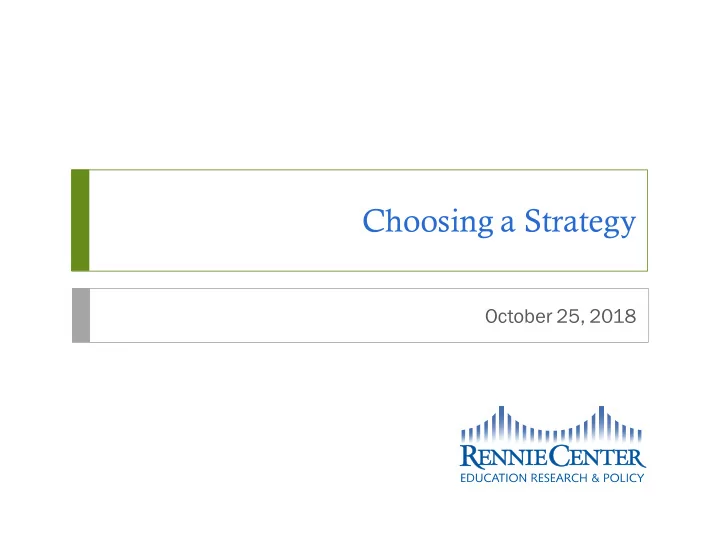

Choosing a Strategy October 25, 2018
Session Goals ▪ Review steps to complete before choosing a strategy ▪ Learn the role of driver diagrams in change management ▪ Identify primary and secondary drivers for a case example ▪ Identify change ideas for a case example 2
Change Management Framework 3
What happens before you choose a strategy? ▪ Ident ntif ify a Proble lem of Practic ice ▪ Math Performance at North Street Elementary School ▪ Less than 50% of students in grades 3-5 are performing on grade level ▪ Average student growth in math is .65 grade levels per year. 4
What happens before you choose a strategy? ▪ Determine ine Root Caus uses Why are students struggling in math? ▪ In 1 st team meeting, teachers identified 2 primary root causes: ▪ Curriculum is not culturally relevant for the student population ▪ Teachers do not know how to expose students to conceptual mathematics 5
What happens before you choose a strategy? ▪ Set a Goal ▪ Create an Aim Statement that embodies principles of a SMART Goal: ▪ Specific ▪ Measurable ▪ Achievable ▪ Relevant ▪ Timely 6
What happens before you choose a strategy? th grade Problem of Practice Stude dent nts not reachi hing ng 5 th de math h pro roficienc ncy y Increase percentage of 5 th grade students achieving What are re we tryi ying ng to accomplish? h? math proficiency based on STAR assessment How much? h? 20 percentage points By when? n? June 2019 Increase 5th grade math proficiency from 41% to 61% Aim Statement nt as measured by STAR by June 2019 7
Driver Diagram Introduction
What is a driver diagram? ▪ Tool to organize planning & action ▪ Visual theory of what contributes to the achievement of an improvement goal * ▪ Evolves as a “living” document – definitely incomplete, possibly wrong Secondary Driver Change Idea Primary Driver Secondary Driver Change Idea Aim Statement Secondary Driver Primary (Improvement Driver Change Idea Goal) Secondary Driver Secondary Driver Primary Change Idea Driver Secondary Driver 9 * http://www.ihi.org/resources/Pages/Tools/Driver-Diagram.aspx
What is a driver diagram? ▪ Systemic view, rather than ‘silver bullet’ ▪ Adaptable, rather than ‘fidelity of implementation’ ▪ Designed with and by the real experts, those closest to the problem ▪ Reflection, rather than compliance Secondary Driver Change Idea Primary Driver Secondary Driver Change Idea Aim Statement Secondary Driver Primary (Improvement Driver Change Idea Goal) Secondary Driver Secondary Driver Primary Change Idea Driver Secondary Driver 10
Better shown than told… Primary Secondary Tertiary Aim Change ideas drivers drivers drivers (Possible interventions) Reduce price per gallon Reduce Decrease Increase miles public transit fuel costs driven Improve car Buy a hybrid next time efficiency Increase Limit speed Stay below 70 mph MPG Improve driving Use appropriate patterns Shift to 5th gear sooner gear Accelerate more slowly Drive more smoothly Stay in 2 nd lane httphttps://www.gov.scot/resource/0042/00426863.pdf 11
Traits of effective driver diagrams ▪ Drivers focus on things within your control ▪ In our example, “increase MPG” is better than “reduce cost per gallon” ▪ Turn & talk : in your school or district context, think of one example of a possible driver that is within your control, and one that is not. 12
Traits of effective driver diagrams ▪ Drivers are measurable ▪ In our example, the tertiary driver “reduce speed” is better than “drive smoothly” ▪ Turn & talk : in your school or district context, think of one example of a possible driver that is measurable, and one that is not. 13
North Street Elementary School Case Study Practice
Activity: Determine Primary Drivers ▪ Primary drivers: ▪ High-level factors which contribute most directly to achieving the improvement goal ▪ Can act independently or in concert Re Refer to Session Worksheet Based on results of the root cause analysis, identify the primary drivers impacting math performance at North Street Elementary School 15
Activity: Determine Secondary Drivers ▪ Secondary drivers: ▪ Lower-level factors that influence the primary drivers ▪ Can be linked to more than one primary driver Re Refer to Session Worksheet Brainstorm secondary drivers impacting each primary driver. Draw lines to indicate which secondary drivers are associated with which primary drivers. 16
Activity: Brainstorm Interventions ▪ Possible interventions: ▪ Ideas the team will test to move towards the aim ▪ Should impact at least 1 secondary driver Refer to Session n Worksheet Working in pairs, brainstorm change ideas that may have an impact on the drivers listed on your diagram. Each team will be asked to share one change idea with the group. 17
Activity: Prioritize Interventions Based on the change ideas shared, determine which one(s) North Street Elementary School should test first. Guiding Questions to Select a Change Idea Which change idea do you anticipate will have the biggest impact Impact on the overall aim? Effort How easy or difficult is this change idea to implement? As a group, choose no more than 2 change ideas to recommend to the principal 18
What comes next?
Plan, Do, Study, Act ▪ Systematically implement, test, and refine your promising change ideas ▪ PDSA cycles rapidly assess whether a change is an improvement 20
Choosing a Strategy ▪ Turn & talk : How might you and/or your team utilize a driver diagram to organize your work toward your own specific improvement goal? Questions? 21
Recommend
More recommend